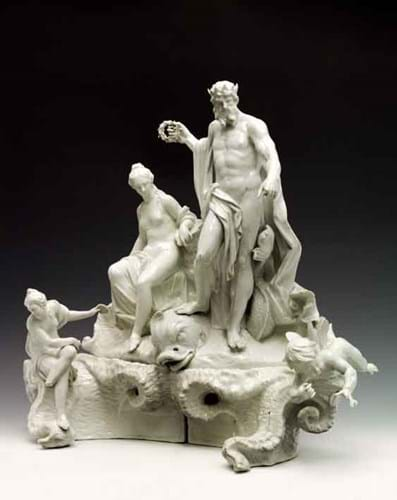
The theatrical white porcelain dining decoration - nearly four metres long - was commissioned by one of the most extravagant characters of the age, Heinrich, Count von Brühl, Prime Minister at the Saxon court in Dresden. It depicts Neptune and the sea goddess Amphitrite being drawn on a shell-chariot by hippocamps and was ordered as a 'scale model' of a fountain built in the gardens of von Brühl's summer palace in Dresden.
The British ambassador in Dresden at the time, Sir Charles Hanbury Williams, wrote about the fountain in a dispatch from 1748: "I was once at a dinner where we sat down at one table two hundred and six people… When the dessert was set on, I thought it was the most wonderful thing I ever beheld. I fancyd myself either in a garden or at the opera. But I [could] not imagine that I was at dinner. In the middle of the table was [a] fountain … , which ran all the while with rose-water, and 'tis said that this piece alone cost six thousand thalers."
When the V&A acquired the fountain in the 1870s, it was described as 'much shattered' and proved too baffling to reconstruct.
Porcelain Puzzle
In seeking to rebuild it, museum curators were confronted with a puzzle made up of more than 150 white porcelain pieces in four storage cabinets. After careful sorting, it was clear that some parts were originals, made between 1745 and 1747, some were missing, some were duplicates or later replacements and many did not belong to the fountain at all.
However, a re-examination of the collection in preparation for the new galleries and a partnership with the Royal College of Art has enabled an ambitious 18-month project to restore the fountain.
In order to achieve the greatest historic accuracy, scanning technology was used to construct accurate 3D models of broken and missing parts. On occasion when certain sections were missing it was possible to digitally 'flip' these images to create mirror images.
'Real' models were then created by machine milling or, for the finer pieces requiring greater detail, printed in resin using cutting-edge 3D printers.
A ceramic artist working at the Royal College of Art is using these to create the missing parts in the same way as the modellers in Meissen would have done. The complexity of the firing and glazing meant that each model needed to be enlarged to 115% of the size of the original pieces to account for shrinkage.
The final reconstruction - a mix of old and new parts - will go on display in the new Europe 1600-1800 galleries, a focal point of the gallery devoted to city and commerce between 1720 and 1780.




